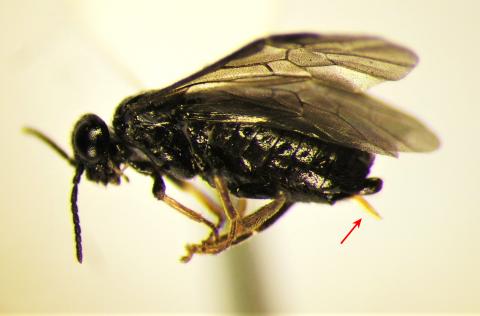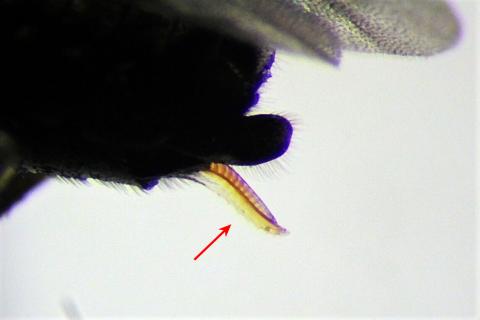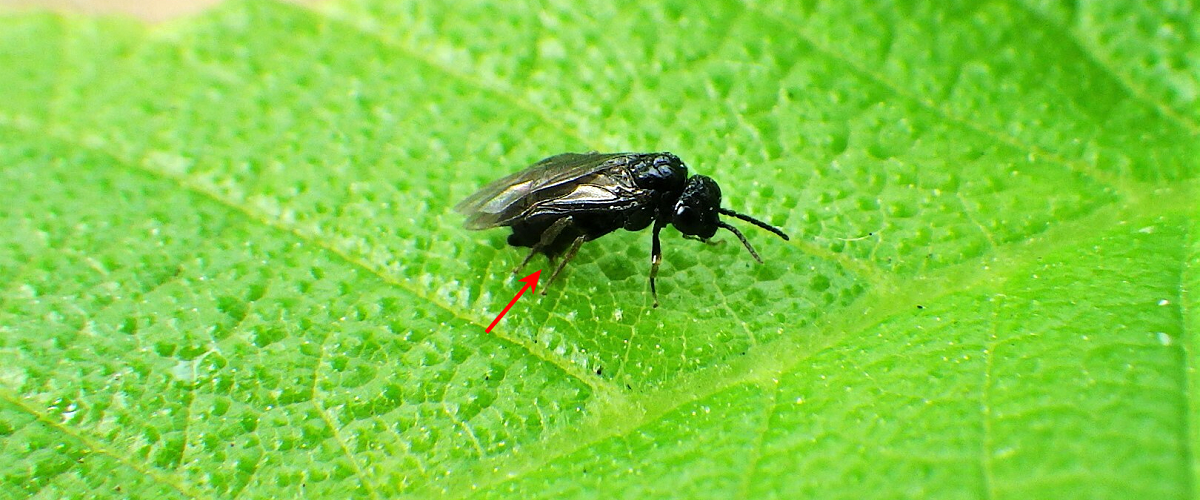(Bio-)Diversity reloaded: the adventures of a citizen scientist in Edmonton
June 15, 2023
By Matthias Buck, Assistant Curator, Invertebrate Zoology
As an entomologist and biologist, I get very excited about the arrival of spring. Finally, the long, dreary winter months are over and nature bursts back to life! Spring flowers, tender green leaves, and of course: all kinds of insects! It was the same for me this year, but the season started with a string of exciting scientific discoveries that I never anticipated.
One of my favorite aspects of my job as Assistant Curator of Invertebrate Zoology is going on field trips to explore Alberta’s diverse ecosystems: the prairies (badlands fascinate me!), the mountains, and the boreal forest. But this spring I was reminded like never before that we are surrounded by biodiversity wherever we are, including in a big city like Edmonton — a diversity that still has a lot of unknowns and is ever changing.
Collecting specimens (lots of them!) for the museum’s collection is a big part of my job. But when I am off work there is something else I love to do: taking pictures of insects. Pinned specimens are critically important for research, but only a picture of the live creature fully reveals its stunning beauty. And if you are lucky, you may also be able to document their fascinating behaviours such as catching prey, building a nest, mating, etc. Therefore, my small point-and-shoot camera gets a good workout and is my steady companion during the summer.
Something else I greatly enjoy is sharing my observations with other nature lovers. Therefore, I upload all my pictures on iNaturalist.ca (my username is @matthias22), a website dedicated to observing and identifying all the species around us, whether it be animals, plants, fungi, or even micro-organisms! As a wasp expert, I have helped many other people identify their observations. And a multitude of people have helped me identify species I am not very familiar with.

Grote’s Sallow (Copivaleria grotei) from Edmonton, Westmount, April 24, 2023
This spring, my journey of discovery started with a few rather drab-looking grey moths that came to the light at my house. Perhaps you’re like me: I’m not a moth expert and the majority of these critters of the night look more or less the same to me, including my first moth of the season (from April 24). It was one I thought I had seen many times before. Well, not so, actually! I observed another one of these a little later and that one was promptly identified as Copivaleria grotei, a Grote’s Sallow by a moth enthusiast from Regina. I had not heard that name before, but it turns out that this species had never been found before in Alberta! My first insect observation of the season — a species new for the province? That surely had to be a fluke!

Grote’s Sallow (Copivaleria grotei) from Edmonton, Westmount, May 4, 2023
Fast forward to May long weekend. Thick smoke everywhere. It certainly did not look like the nicest holiday weekend in recent memory. But I kept my spirits up and had a lovely day in the field at the Bilby Natural Area northwest of Edmonton. I was able to take some nice images of species I hadn’t photographed before, but I did not know that the highlight of my day still lay ahead. It was waiting for me in the evening next to my balcony light: another small moth, this one even tinier and drabber looking than the first. It was a so-called micromoth, an informal assemblage of species that mainly stands out because of its small size (moth aficionados fondly call them “micros”).

Elm Leaftier Moth (Canarsia ulmiarrosorella) from Edmonton, Westmount, May 20, 2023
When I uploaded the image on iNaturalist I had my second big surprise of the season! This time, I used iNaturalist’s computer vision, an inbuilt computer algorithm that identifies species by comparing the image to other images that have already been identified to species. In my case, computer vision suggested a species that was only known from eastern North America! It is called Canarsia ulmiarrosorella (you should let that name roll over your tongue!) Its English name is so much more boring: Elm Leaftier Moth.

iNaturalist observations of the Elm Leaftier Moth (Canarsia ulmiarrosorella). Way up on the left is my observation from Westmount, Edmonton. Source: iNaturalist.ca, Google
Obviously, machines can’t replace the brain, so I went to a reputable website that has images of nearly every moth species in North America (can you pick out the one?). After sifting through dozens of very similar looking images it still looked like a very good match for this species. To be certain I also asked a couple of colleagues who are micro experts, and all of them confirmed that this was indeed Canarsia ulmiarrosorella. Welcome to the Canadian Prairies!
Now this was only moth #6 I had photographed so far this year. Another new record, this time for all of Western Canada? Certainly, that had to be it for a while as far as new discoveries go. But the weekend wasn’t over yet, and good things usually come in threes (disclaimer: that’s not scientifically proven).
Like many of you, I go for walks through my neighbourhood, especially on weekends. On the Sunday of May long weekend, I walked less than 200m from my house when I noticed a small black dot on the leaf of an elm tree in the street. I was curious and thought this was going to be a certain kind of fly I was familiar with from my research (flies are another group I specialize in). To my surprise, it was a tiny sawfly — the smallest I had ever seen! Sawflies aren’t actually flies but belong in the insect order Hymenoptera. Besides sawflies, it includes more familiar groups such as wasps, bees, and ants.

Elm Leafminer (Fenusa ulmi) female ovipositing into an elm leaf. The red arrow points to the ovipositor. Edmonton, Westmount, May 21, 2023.
So, what about this little hymenopteran? Strangely, it sat completely still and did not fly away when I moved close to take pictures — I even was able to collect it afterwards. When I looked at the pictures, the reason was revealed: I had surprised a female at the very moment when she was ovipositing into a leaf! Female sawflies have a unique, blade-like ovipositor with microscopic teeth that allows them to insert their eggs directly into the host plant where the larva will later feed.
This was an important clue: most herbivorous insects are host-specific, and this information can make species identification a lot easier. When I uploaded my pictures and let computer vision do its magic, the confirmation came promptly: Fenusa ulmi, the Elm Leafminer — voilà! The identification was confirmed by another colleague who specializes in sawflies. And this was yet another species that had never been found before in Alberta! Fenusa ulmi is a European species that was accidentally introduced to North America. It is well-known from Ontario and BC but had never been found before on the Prairies. That made three new records for the province within four weeks, all within a stone throw off my home in an average Edmonton neighbourhood!

Elm Leafminer (Fenusa ulmi) female from Edmonton. The arrow points to the ovipositor. Body length 4mm. The specimen is now deposited in the museum’s collection.
From a biological perspective, there are some interesting commonalities between these three discoveries: firstly, they all involve species that feed on non-native plants. In this case, elm and ash trees which are common boulevard trees in Edmonton. Secondly, at least two of them (the Elm Leafminer and Elm Leaftier) have likely been introduced to Edmonton by accident through human activity (e.g., with nursery plants or as hitchhikers in shipped goods). Accidental introductions of insects and other invertebrates happen more and more often in a world that is becoming ever more connected by global trade routes. You might remember my blog post about the Variegated Lady Beetle from last fall. Urban areas have become hotspots for introduced species, and citizen scientists are often the first ones to discover them! Our urban ecosystems are worth paying attention to. You can make a real difference.

Close-up view (arrow) of the blade-like ovipositor of the Elm Leafminer (Fenusa ulmi). It is used to slice open plant tissue in order to insert an egg.
It has never been easier to become a nature observer. Within the last three decades there has been a true revolution in the exploration of biodiversity. With cell phones and digital photography so easily accessible, we can share our observations in real time with a worldwide community of naturalists through internet platforms like iNaturalist. The naturalist community has never been more educated about such a large variety of organisms — no longer just birds and butterflies! Now we even have artificial intelligence that aids our identification efforts through computer vision and a variety of other apps. And the number of excellent identification resources both online and in print has developed exponentially. During my youth I only had a couple of field guides — that was it!
If you enjoy nature and living creatures, I encourage you to get out there and start exploring. There is always something interesting to observe, wherever you are. You don’t have to be in a provincial park or a natural area. Your adventure can begin right in your own backyard, your own street, your own neighbourhood park. Happy exploring!
